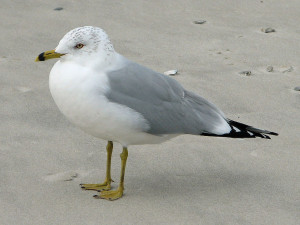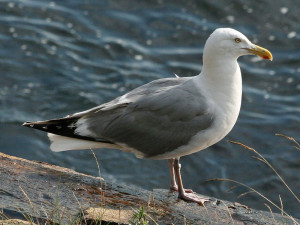From Arthur Conan Doyle’s Sherlock Holmes story “Silver Blaze:”
Gregory (Scotland Yard detective): “Is there any other point to which you would wish to draw my attention?”
Holmes: “To the curious incident of the dog in the night-time.”
Gregory: “The dog did nothing in the night-time.”
Holmes: “That was the curious incident.”
From the deck of the MS Vandeem cruising down the St. Lawrence River:
Fellow Cruiser: “Is there any other point to which you would wish to draw my attention?”
Me: “To the curious incident of the sea gulls.”
Fellow Cruiser: “But there are no sea gulls.”
Me: “That is the curious incident.”
In anticipating our cruise down the St. Lawrence I prepared myself for two ecological experiences: 1. I anticipated seeing great flocks of sea birds (especially sea gulls) all along the river and estuary, and 2. I anticipated seeing whales (13 species of whales (from belugas to blue whales) spend their springs and summers in the St. Lawrence River and Gulf!). Amazingly, though, there were almost no seagulls or other sea birds to be seen over the week of the cruise, and the only whale we observed was a harbor dolphin that Deborah spotted in Bar Harbor, Maine! The whales might have been avoiding the noise and fuss of our large cruise ship (The MS Vandeem), but sea gulls, based on my experiences along the Texas Gulf Coast and the Virginia mid-Atlantic coasts, should have been drawn to this boat and to the various port towns we stopped at like flies to a picnic!
Where were they?
Background reading about the birds of eastern Canada listed four main sea gull species: the ring-billed gull (Larus delawarensis), the herring gull (L. argentatus), the great black-backed gull (L. marinus) and the black-legged kittiwake (Rissa tridactyla). The great black-backed gull and the black-legged kittiwake are most frequently found to the north and to the seaward sides of the places we were scheduled to visit (they are true seas dwelling gulls, not, as my cousin Amy recently pointed out to me, bay dwelling “bagels!” (Happy retirement, Amy!)), so my expectation was that we would see quite a few ring-billed gulls (they were estimated to make up 80% of the gulls along the St. Lawrence) and herring gulls (estimated to make up 10% of the St. Lawrence gulls). In fact, the largest single breeding colony of ring-billed gulls was quite close to where we boarded the Vandeem just east of Montreal (on the Ile Deslauriers: a colony of 51,000 pairs of birds!). Unfortunately, we could not see this island from the deck of our boat! We did see several great blue herons (Ardea herodias) flying over Montreal and down the St, Lawrence just before we boarded the Vandeem, but not many other birds at all!
Along the Quebec stretch of the St. Lawrence we saw a handful of herring gulls but no ring-billed gulls. When we docked at Quebec City, there were no waiting flocks of gulls of any kind to greet us as we disembarked from the boat. As we continued down the St. Lawrence from Quebec City and headed out into the Gulf of the St. Lawrence, we saw a few more herring gulls, a couple of ring-billed gulls, and a pair of common terns (Sterna hirundo). When we docked at Charlottetown, Prince Edward Island (or Sydney or Halifax, Nova Scotia) there were also no flocks of gulls, no great flying commotion greeting us on the docks.
In Charlottetown we sat out on a dockside table and had several baskets of steamed mussels and clams (and a very fine local ale). We watched two double crested cormorants (Phalacrocorax auritus) stand to dry themselves out on some old pilings in the harbor but were neither entertained nor pestered by any gulls. We had a similar experience on the waterfront boardwalk in Halifax (in Sydney it was far too cold and wet to sit outside! We did see, though, a pair of American black ducks (Anas rubripes) swimming around in a little cove near the dock).
Where were the sea gulls?
Herring gulls have been having a very tough time of it over the past fifty years. The Cornell Laboratory of Ornithology reports that their population has decline 3.5% each year since 1966. That percentage has compounded into an 83% total population decline over this time period! Changes in commercial fishing methods (less dumping of waste fish and refuse), a significant decline in total commercial fishing due to depleted fish populations, and greater control over landside waste disposal, waste dumps and landfills have all reduced the available food for this active, omnivorous scavenger. Further, oil and pesticide pollution and the loss of nesting sites have all had negative impacts on herring gulls. Also, herring gulls incubate their eggs in their huge nesting colonies for over a month, and their nestlings don’t fledge until they are six weeks old! This extended period of egg and nestling existence makes the herring gull quite vulnerable to nest predators (a list that even includes their fellow herring gulls!) and to deliberate human destruction of eggs!
There was an article in The Guardian (June 30, 2010) asking the question, “Why were there no seagulls in Charlottetown. PEI?” One answer came from a reader who reported that a friend of theirs had worked for the Royal Society for the Preservation of Birds (RSPB) back in the 1960’s systematically destroying seagull eggs in nearby PEI colonies (seagulls, according to the RSPB, needed to be destroyed because of their habits of eating the eggs and nestlings of other bird species!).
Another article I found was published in 2014 on the CBC News web site. This article featured a Harris’s hawk named “Nova” that was hired (along with his handler) by the city of Halifax to patrol the harbor area of the city. The hawk actively killed seagulls and generated a predator presence that greatly reduced the local seagull population!
Deliberate human actions, then, seem to have been one factor in reducing the local presence of seagulls especially in places that wanted outdoor restaurants and harbor-side walkways for tourists (i.e. all of the places that the MS Vandeem took its travelers!).
Another factor that might have been impacting the number of sea gulls that we observed, though, might simply have been the timing of our visit. Both the herring gull and the ring-billed gull were right in the middle of their seasonal nesting periods. Possibly their colonies have been driven far enough away from the high human-use sites of our cruise ship itinerary that the birds were not able to make forays into these towns while still protecting their nests or feeding their nestlings. I like to think that in August the sea gull numbers in this visitation sites would improve. I would be happy to wear a broad-billed hat (and even put a cover over my glass of ale or basket of shellfish) when sitting out at a dockside table if it would mean an accompanying show and clatter of gulls!






Very interesting post about the spring-summer-season mystery up there. Here’s a website for gull research being conducted by the University of Quebec at Montreal, which you may know about already:
http://goeland.uqam.ca/index.php/en/
It doesn’t indicate whether extensive gull control projects are active along the St. Lawrence.
My Ring-billed species account in the 2nd PA Breeding Bird Atlas describes control projects on a manufacturing plant roof in the city of Erie. Nests were removed over a period of several years, and the colony left permanently as far as I know.
It’s a shame in a way, but these huge colonies seem to give cities and airports a lot of problems, and health concerns for humans have been suggested.
Tens of thousands of R-b Gulls were along the Niagara River and nearby reservoirs and landfills when we lived in Niagara Falls in the late 1980s. A friend and I still see huge numbers every December when we go to the river for a gull-watching trip, but these are winterers. I don’t think any have nested in large numbers in that area. Niagara and PA are at the far southeastern fringe of the breeding range, of course, and it may be retracting from wherever control projects chase nesting colonies away.
Anyhow… It’s still surprising and intriguing that there weren’t good numbers on your trip even in the breeding season. Typically, many nonbreeding immature Ring-bills remain on the wintering grounds along Lake Erie and Lake Ontario.
Paul
Sad